Emerging contaminants, such as perfluoroalkyl substances (PFASs), pharmaceuticals and personal care products (PPCPs) have received great attention from the public and scientific community due to their potential adverse impacts on the ecosystem and human health. These emerging contaminants enter into receiving environment, including aquatic environment, after use. The emerging contaminants will further bioaccumulate into aquatic biota and be biodegraded and transformed by various organisms.
For ionizable emerging contaminants, such as antibiotics, pharmaceuticals, and personal care products, they can be detected not only in muscle and liver, but also in bile and plasma biological samples from wild fish. And these chemicals displayed different bioaccumulation patterns as the traditional persistent organic pollutants (POPs) in biological samples. Emerging contaminants, such as environmental hormones, can be biodegraded by microorganisms from active sludge of wastewater treatment plants or algae from the aquatic environment; further application using microorganisms and algae to remove these kinds of pollutants is warranted.
(1). Bioaccumulation of PFASs and PPCPs
Pearl River and Yangtze River regions are the most developed areas in China. In these regions, industrial wastewater, livestock wastewater, and domestic wastewater are largely discharged into the receiving environment. Previous studies demonstrated that PFASs and PPCPs were detected ubiquitously in surface water and sediments in Pearl River and Yangtze River. Subsequently, organisms inhabiting in those environments may accumulate these pollutants.
We collected wild fish from Pearl River (Huizhou section of Dongjiang River, Shima River, Danshui River, and Xizhijiang River) and Yangtze River (Yichang, Wuhan, Nanjing, and Zhenjiang). Fish muscle, liver, plasma and bile samples were dissected. Firstly, methods were developed to extract and analyze antibiotics, PCPs, and PFASs in composite biological samples. SAX/PSA cartridge was used in tandem to HLB cartridge to remove the lipid and protein during antibiotic analysis. QuEChERS extraction and purification kits were used to extract PCPs from biota. For PFASs, PFOS was found to be the predominant PFAS both in muscle and liver with its highest concentrations of 79 ng/g wet weight (ww) in muscle and 1500 ng/g ww in liver. The mean bioaccumulation factors (log BAFs) in fish for the PFASs were in the range from 2.7 to 3.4. Among 26 antibiotics, 12 antibiotics were detected in biological samples of wild fish. Especially in bile samples, antibiotics were found at higher frequencies. The mean log BAFs in bile, plasma, liver and muscle were 2.06–4.08、1.85–3.47、1.41–3.51、0.48–2.70, respectively. Among 24 PCPs, 13 PCPs were detected in muscle and liver tissues of wild fish. Galaxolide was found to have the maximum concentrations of 299 ng/g and 2620 ng/g ww in muscle and liver, respectively. The mean log BAFs in muscle and liver were 0.63–3.45 and 0.84–4.73.
We investigated the uptake, disposition, and toxicokinetics of five pharmaceuticals (diclofenac, methocarbamol, rosuvastatin, sulfamethoxazole, and temazepam) in bluegill sunfish (Lepomis macrochirus) exposed to environmentally relevant concentrations (1,000–4,000 ng L−1) in a flow-through exposure system. Temazepam and methocarbamol were consistently detected in bluegill biological samples with the highest concentrations in bile of 4, 940 and 180 ng g−1, respectively, while sulfamethoxazole, diclofenac, and rosuvastatin were only infrequently detected. Over 30-day exposures, the relative magnitude of mean concentrations of temazepam and methocarbamol in biological samples generally followed the order: bile ≫ gut > liver and brain > muscle, plasma, and gill. Ranges of bioconcentration factors (BCFs) in different biological samples were 0.71–3,959 and 0.13–48.6 for temazepam and methocarbamol, respectively. Methocarbamol and temazepam underwent rapid uptake and elimination in bluegill biological compartments with uptake rate constants (Ku) and elimination rate constants (Ke) at 0.0066–0.0330 h−1 and 0.0075–0.0384 h−1, respectively, and half-lives at 18.1–92.4 h. Exposure to mixtures of diclofenac, methocarbamol, sulfamethoxazole, and temazepam had little or no influence on the uptake and elimination rates, suggesting independent multiple uptake and disposition behaviors of pharmaceuticals by fish would occur when exposed to effluent-influenced surface waters.
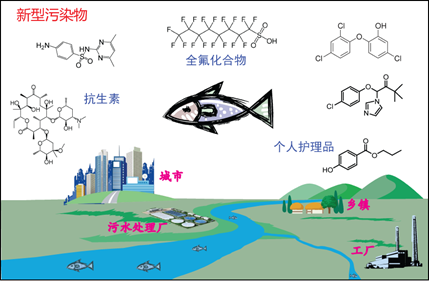
Figure 14. Potential bioaccumulation of emerging contaminants in wild fish.
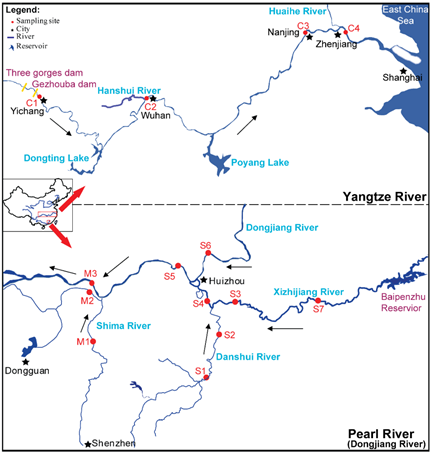
Figure 15. Fish sampling sites in the Pearl River and Yangtze River.
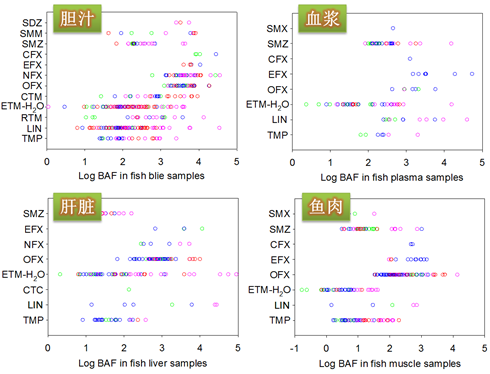
Figure 16. The bioaccumulation factors of antibiotics in different biological samples of wild fish.
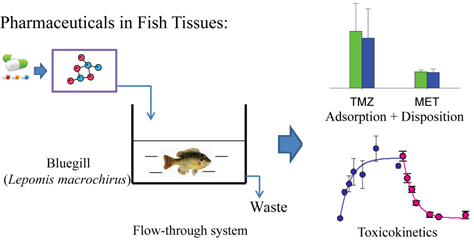
Figure 17. The uptake/elimination metabolism of pharmaceuticals in fish biological compartments.
(2). Biodegradation and Biotransformation of Emerging Contaminants.
Microorganisms play an important role in the fate of chemicals in the environment. We investigated aerobic biodegradation of progesterone and norgestrel by bacteria from activated sludge, and identified their degradation products and biotransformation pathways. The degradation of progesterone followed the zero order reaction kinetics (T1/2 = 4.3 h), while norgestrel followed the first order reaction kinetics (T1/2 = 12.5 d). Eight and four degradation products were identified for progesterone and norgestrel, respectively. One progesterone-degrading bacterial strain and six norgestrel-degrading bacterial strains were successfully isolated from the enrichment culture inoculated with aerobic activated sludge.
Algae can also play an important role in the environmental fate of contaminants since they are widespread in the aquatic environment and can interact with organic and inorganic substances. We investigated the degradation process of progesterone and norgestrel by microalgae in lab scale. More than 95% of progesterone was removed by the two microalgae within five days. For norgestrel, almost complete removal by S. obliqnuus was observed after five days, but nearly 40% was remained when incubated with C. pyrenoidosa. The results also showed that these two compounds were not accumulated in the algal cells. Biodegradation was found to be the main mechanism for their removal in the aqueous solutions, and it followed the first-order kinetic model. For progesterone, three main transformation products, i.e. 3β-hydroxy-5α-pregnan-20-one, 3,20-allopregnanedione and 1,4-pregnadiene-3,20-dione, and six minor androgens were identified. For norgestrel, only two transformation products, 4,5-dihydronorgestrel and 6,7-dehydronorgestrel, were identified for the first time. Hydroxylation, reduction and oxidation are proposed to be the main degradation pathways.
Algal degradation of BPA and TBBPA was also investigated. Pseudokirchneriella subcapitata was found to have the ability to degrade TBBPA into its sulfated and glycosylated compounds, while Scenedesmus acuminatus was demonstrated to have O-methylation ability. The results clearly demonstrated the capability of the microalgae to degrade the emerging contaminants, suggesting the potential future application in wastewater treatment.
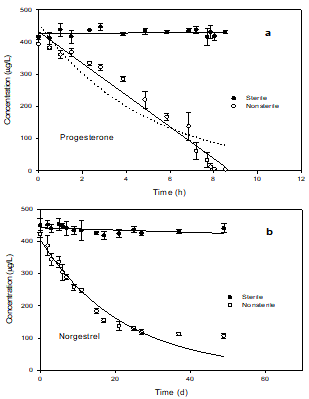
Figure 18. Degradation Curves for progesterone and norgestrel.
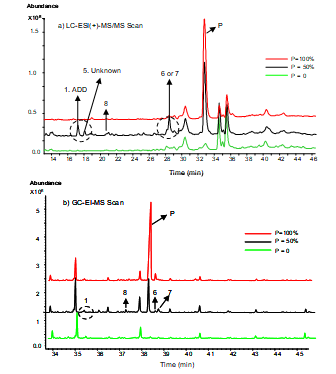
Figure 19. Progesterone (P) and its degradation products under aerobic condition.
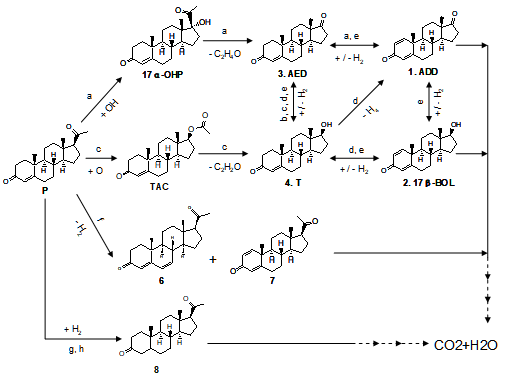
Figure 20. Proposed pathways for the biotransformation of progesterone (P) under aerobic condition.
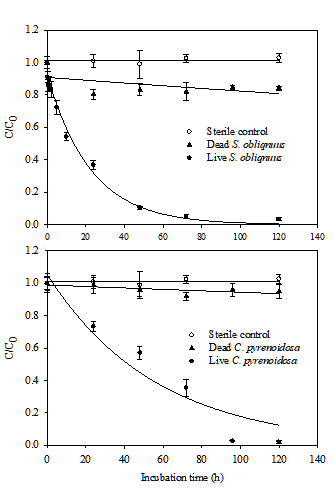
Figure 21. Degradation of progesterone by S. obliqnuus and C. pyrenoidosa.
References:
(1) Yao L, Zhao JL, Liu YS, Zhang QQ, Jiang YX, WR Liu WR, Yang YY, Ying GG. Personal care products in wild fish: Bioaccumulation potential and human health risks. Submitted to Journal of Hazardous Materials, Under review.
(2) Zhao JL, Furlong ET, Schoenfuss HL, Kolpin DW, Bird KL, Feifarek DJ, Schwab EA, Ying GG. 2017. Uptake and disposition of select pharmaceuticals by bluegill exposed at constant concentrations in a flow-through aquatic exposure system. Environmental Science & Technology, 51(8): 4434-4444.
(3) Yao L, Zhao JL, Liu Y-S, Yang YY, Liu W-R, Ying GG. 2016. Simultaneous determination of 24 personal care products in fish muscle and liver tissues using QuEChERS extraction coupled with ultra pressure liquid chromatography-tandem mass spectrometry and gas chromatography-mass spectrometer analyses. Analytical and Bioanalytical Chemistry, 408(28): 8177-8193.
(4) Zhao JL, Liu YS, Liu WR, Jiang YX, Su HC, Zhang QQ, Chen XW, Yang YY, Chen J, Liu SS, Pan CG, Huang GY, Ying GG. 2015. Tissue-specific bioaccumulation of human and veterinary antibiotics in bile, plasma, liver and muscle tissues of wild fish from a highly urbanized region. Environmental Pollution, 198: 15-24.
(5) Liu S, Chen H, Xu XR, Liu SS, Sun KF, Zhao JL, Ying GG. 2015. Steroids in marine aquaculture farms surrounding Hailing Island, South China: Occurrence, bioconcentration, and human dietary exposure. Science of the Total Environment, 502: 400-407.
(6) Peng FQ, Ying GG, Yang B, Liu YS, Lai HJ, Zhou GJ, Chen J, Zhao JL. 2014. Biotransformation of the flame retardant tetrabromobisphenol-A (TBBPA) by freshwater microalgae. Environmental Toxicology and Chemistry, 33(8): 1705-1711.
(7) Pan CG, Zhao JL, Liu YS, Zhang QQ, Chen ZF, Lai HJ, Peng FJ, Liu SS, Ying GG. 2014. Bioaccumulation and risk assessment of per- and polyfluoroalkyl substances in wild freshwater fish from rivers in the Pearl River Delta region, South China. Ecotoxicology and Environmental Safety, 7: 192-199.
(8) Zhou GJ, Ying GG, Liu S, Zhou LJ, Chen ZF, Peng FQ (2014) Simultaneous removal of inorganic and organic compounds in wastewater by freshwater green microalgae. Environmental Sciences: Processes & Impacts 16, 2018-2027.
(9) Liu S, Ying GG, Liu YS, Peng FQ, He LY (2013) Degradation of norgestrel by bacteria from activated sludge: comparison to progesterone. Environmental Science & Technology 47, 10266-10276.
(10) Zhou GJ, Peng FQ, Yang B, Ying GG (2012) Cellular responses and bioremoval of nonylphenol and octylphenol in the freshwater green microalga Scenedesmus obliquus. Ecotoxicology and Environmental Safety 87, 10-16.